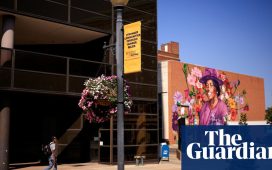In Yuma, south-west Arizona, just a short distance from a gap in the 30-foot-high border barrier between the US and Mexico, Fernando “Fernie” Quiroz collects piles of shoes, shoelaces and clothing from the dirt road and carries them to a large red dumpster already overflowing with personal belongings.
Every day, hundreds of people arrive at gaps in this stretch of border wall to request political asylum from uniformed federal border agents who stand waiting under a rudimentary metal shade structure in the Sonoran desert heat.
Most of those arriving to seek asylum are from Cuba, Venezuela, Colombia, Romania, or other eastern European countries.
Official ports of entry dotted along the almost 2,000-mile-long border stretching from the California coast to the Gulf coast of south Texas remain closed to asylum seekers under the government’s enduring title 42 public health statute established by Donald Trump’s administration at the beginning of thepandemic.
So instead migrants arrive at ad-hoc places like these gaps in the wall, alongside the dried-up bed of the Colorado River, to exercise their right to request asylum.
In some circumstances, including dangerous conditions in their country of origin, and the distance and difficulty in returning the people there, asylum seekers are exempted from the summary expulsion under title 42 that has upended so many desperate journeys.
But to get to the next step in the asylum process, agents in Yuma, according to Customs and Border Protection, require they leave everything behind, except for what they can fit into a small plastic Department of Homeland Security-issued bag.
Border residents in Arizona and Texas have observed an increasing number of personal belongings left along the US side of the border wall in the last two years.
Usually people leave clothing and sundries, but items such as passports, birth certificates, police reports, and other confidential documents that could be crucial in proving asylum cases have been found abandoned, too.
One one trip to the dumpster, Quiroz, director of the AZ-CA Humanitarian Coalition migrant assistance group, came across a navy blue Haitian passport and Cuban passports just lying in the dirt, and he said he can’t begin to fathom why.
“Our ports of entries were set up for individuals coming from other countries, and that is where they should be going,” he said, to take part in an orderly and fair legal process.
“But they’re not allowed to do that. So, they come here,” he added, indicating the harsh desert and intimidating barrier with its tall metal stakes.
He has found rosaries, diaper bags, purses, airline ticket stubs and used face masks. Now the phenomenon is cropping up as a popular backdrop for rightwingers keen on inflammatory immigration talk, and with Texas Republican governor Greg Abbott, under pressure to declare “an invasion” – especially with the midterm elections looming.
Some senior US Border Patrol figures are chiming in. Brandon Judd, union president of the National Border Patrol Council, promoted a white supremacist theory on Fox News last month, claiming that Democrats were going to lift title 42 “to change the demographics of the electorate”.
And USBP noted it was Earth Day on 22 April by posting pictures on Instagram of asylum seekers’ belongings with the message that it was “trash and litter left behind by illegal immigration”.
In Texas, Brian Hastings, border patrol chief for the Rio Grande Valley sector – another busy corridor for migrant arrival – last summer tweeted “It’s piling up” and labeled images of people’s property “burdensome trash”.
But Quiroz said: “It’s not that they’re [asylum seekers] leaving a mess. When Border Patrol shows up, they tell them to drop everything and get in line.”
Some coalition volunteers began cleaning up the Yuma stretch of border. The county placed two large dumpsters nearby. They also persuaded border patrol to provide shade structures and water for arriving asylum seekers.
But he claimed: “Some politicians are disappointed because we cleaned it up. It’s not the visual they want to see for the narrative they want to tell.”
In some parts of Texas, so many belongings are left behind that border patrol use heavy machinery to “shove it off into piles at the side of the road,” said Scott Nicol, an environmental activist and artist based in McAllen, near the easternmost point of the US-Mexico border.
He has also found personal and confidential documents on his walks along the border.
“What really got to me were the X-rays I found. They were for a six-year-old boy and showed a steel rod in his spine. It was obviously for an asylum claim. Why would anyone part with those?” he said.
He said he has even found birth certificates “torn into a hundred pieces and thrown into the brush”.
The Guardian sent images of passports, birth certificates and other documents found at the border wall to Customs and Border Protection, the federal agency overseeing border agents, and requested comment on whether agents were telling asylum seekers to leave their documents behind, and in some cases ripping them up.
CBP declined to respond to the questions.
In an email, a CBP spokesperson replied that they “could not speculate on the motivation of an individual discarding copies of personal vital statistic documentation”.
When asked about the personal items left behind, CBP wrote in an email that border patrol has a “policy prohibiting certain items deemed a health hazard, that includes wet or moldy clothes, from entering CBP facilities.”
The spokesperson added: “Items not deemed contraband, or a health hazard are stored and returned to the migrant upon release or will accompany them if transferred to the custody of another agency.”
But increasingly people arrive at migrant shelters in the US with only the clothes on their backs, and without any identification.
Joanna Williams, executive director of the Kino Border Initiative, a binational migrant advocacy organization that runs a shelter in Nogales, on the Mexican side of the border south of Tucson, Arizona, said one theory she’s heard is that smugglers advise migrants to dump their identifying documents when they cross.
But in the thousands of intake interviews with migrants the organization has done, Williams said, they’ve never once heard from someone who had left their documents behind because a smuggler told them to do so.
“The families that we see, who carry things related to their asylum cases, are very clear on the fact that these are important documents, and very concerned about them, if they get misplaced,” she said.
However, after the Trump administration began its Remain in Mexico policy for many crossing the border unauthorized, some migrants told them agents ripped up their Mexican immigration visas and other documents.
“The agents would say that they were fake documents when they were actually real, and they really needed them,” she said.
Blake Gentry, director of the indigenous language office at Casa Alitas, a migrant shelter in Tucson, estimated that about a third of people arrive at the shelter without documents or belongings.
He suspects some agents are forcing migrants to dump their possessions in some sort of rogue practice.
“If this is happening on the US side of the wall, it’s most likely Border Patrol,” he said.








